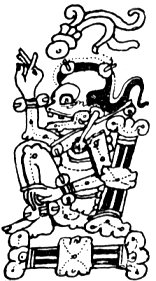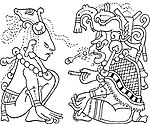
Aztec mythology is the body or collection of myths of the Aztec civilization of Central Mexico. The Aztecs were Nahuatl-speaking groups living in central Mexico and much of their mythology is similar to that of other Mesoamerican cultures. According to legend, the various groups who were to become the Aztecs arrived from the north into the Anahuac valley around Lake Texcoco. The location of this valley and lake of destination is clear – it is the heart of modern Mexico City – but little can be known with certainty about the origin of the Aztec. There are different accounts of their origin. In the myth the ancestors of the Mexica/Aztec came from a place in the north called Aztlan, the last of seven nahuatlacas to make the journey southward, hence their name "Azteca." Other accounts cite their origin in Chicomoztoc, "the place of the seven caves", or at Tamoanchan.
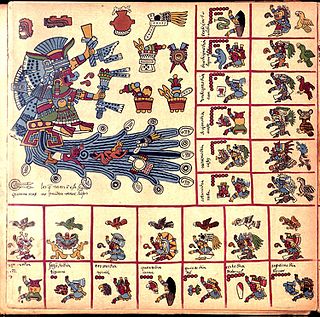
Chalchiuhtlicue is an Aztec deity of water, rivers, seas, streams, storms, and baptism. Chalchiuhtlicue is associated with fertility, and she is the patroness of childbirth. Chalchiuhtlicue was highly revered in Aztec culture at the time of the Spanish conquest, and she was an important deity figure in the Postclassic Aztec realm of central Mexico. Chalchiuhtlicue belongs to a larger group of Aztec rain gods, and she is closely related to another Aztec water god called Chalchiuhtlatonal.

Mictlāntēcutli or Mictlantecuhtli, in Aztec mythology, is a god of the dead and the king of Mictlan (Chicunauhmictlan), the lowest and northernmost section of the underworld. He is one of the principal gods of the Aztecs and is the most prominent of several gods and goddesses of death and the underworld. The worship of Mictlantecuhtli sometimes involved ritual cannibalism, with human flesh being consumed in and around the temple. Other names given to Mictlantecuhtli include Ixpuztec, Nextepehua, and Tzontemoc.

Huehueteotl is an aged Mesoamerican deity figuring in the pantheons of pre-Columbian cultures, particularly in Aztec mythology and others of the Central Mexico region. The spellings Huehuetéotl and Ueueteotl are also used. Although known mostly in the cultures of that region, images and iconography depicting Huehueteotl have been found at other archaeological sites across Mesoamerica, such as in the Gulf region, western Mexico, Protoclassic-era sites in the Guatemalan highlands such as Kaminaljuyú and Late-Postclassic sites on the northern Yucatán Peninsula. The name Huehueteotl stems from Nahuatl huēhueh ("old") and teōtl ("god"). It seems to connect the Old God to certain Mayan deities called Mam ("Grandfather").
Huracan, often referred to as U Kʼux Kaj, the "Heart of Sky", is a Kʼicheʼ Maya god of wind, storm, fire and one of the creator deities who participated in all three attempts at creating humanity. He also caused the Great Flood after the second generation of humans angered the gods. He supposedly lived in the windy mists above the floodwaters and repeatedly invoked "earth" until land came up from the seas.

In the Late Post-Classic Maya mythology of the Popol Vuh, Camazotz is a bat spirit at the service of the lords of the underworld. Camazotz means "death bat" in the Kʼicheʼ language. In Mesoamerica generally, the bat is often associated with night, death, and sacrifice.
Tohil was is the Maya god of fire. He is a deity of the Kʼicheʼ Maya in the Late Postclassic period of Mesoamerica.

Cocijo is a lightning deity of the pre-Columbian Zapotec civilization of southern Mexico. He has attributes characteristic of similar Mesoamerican deities associated with rain, thunder and lightning, such as Tlaloc of central Mexico, and Chaac of the Maya civilization. In the Zapotec language, the word cocijo means "lightning", as well as referring to the deity.
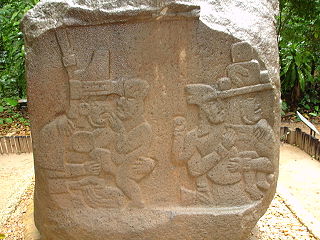
The Maya Hero Twins are the central figures of a narrative included within the colonial Kʼicheʼ document called Popol Vuh, and constituting the oldest Maya myth to have been preserved in its entirety. Called Hunahpu and Xbalanque in the Kʼicheʼ language, the Twins have also been identified in the art of the Classic Mayas. The twins are often portrayed as complementary forces.
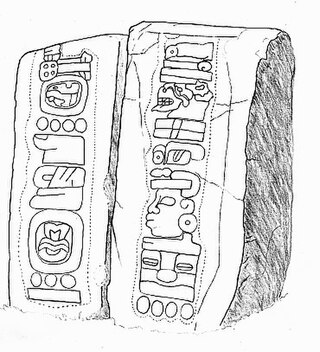
The calendrical systems devised and used by the pre-Columbian cultures of Mesoamerica, primarily a 260-day year, were used in religious observances and social rituals, such as divination.
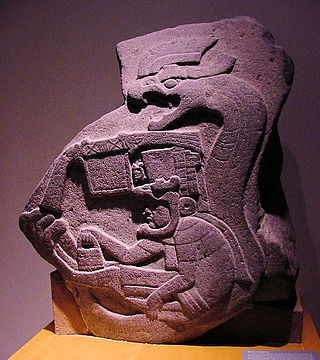
The religion of the Olmec people significantly influenced the social development and mythological world view of Mesoamerica. Scholars have seen echoes of Olmec supernatural in the subsequent religions and mythologies of nearly all later pre-Columbian era cultures.
Xquic is a mythological figure known from the 16th century Kʼicheʼ manuscript Popol Vuh. She was the daughter of one of the lords of Xibalba, called Cuchumaquic, Xibalba being the Maya underworld. Noted particularly for being the mother of the Maya Hero Twins, Hunahpu and Xbalanque, she is sometimes considered to be the Maya goddess associated with the waning moon. However, there is no evidence for this in the Popol Vuh text itself.

K’uk’ulkan, also spelled Kukulkan, is the serpent deity of Maya mythology. It is closely related to the deity Qʼuqʼumatz of the Kʼicheʼ people and to Quetzalcoatl of Aztec mythology. Prominent temples to Kukulkan are found at archaeological sites in the Yucatán Peninsula, such as Chichen Itza, Uxmal and Mayapan.

Karl Andreas Taube is an American Mesoamericanist, Mayanist, iconographer and ethnohistorian, known for his publications and research into the pre-Columbian cultures of Mesoamerica and the American Southwest. He is Distinguished Professor of Anthropology at the College of Humanities, Arts, and Social Sciences, University of California, Riverside. In 2008 he was named the College of Humanities, Arts, and Social Sciences distinguished lecturer.

The Feathered Serpent is a prominent supernatural entity or deity, found in many Mesoamerican religions. It is still called Quetzalcoatl among the Aztecs, Kukulkan among the Yucatec Maya, and Q'uq'umatz and Tohil among the K'iche' Maya.

In Mesoamerican culture, Tonatiuh is an Aztec sun deity of the daytime sky who rules the cardinal direction of east. According to Aztec Mythology, Tonatiuh was known as "The Fifth Sun" and was given a calendar name of naui olin, which means "4 Movement". Represented as a fierce and warlike god, he is first seen in Early Postclassic art of the Pre-Columbian civilization known as the Toltec. Tonatiuh's symbolic association with the eagle alludes to the Aztec belief of his journey as the present sun, travelling across the sky each day, where he descended in the west and ascended in the east. It was thought that his journey was sustained by the daily sacrifice of humans. His Nahuatl name can also be translated to "He Who Goes Forth Shining" or "He Who Makes The Day." Tonatiuh was thought to be the central deity on the Aztec calendar stone but is no longer identified as such. In Toltec culture, Tonatiuh is often associated with Quetzalcoatl in his manifestation as the morning star aspect of the planet Venus.
Wayob is the plural form of way, a Maya word with a basic meaning of 'sleep(ing)', but which in Yucatec Maya is a term specifically denoting the Mesoamerican nagual, that is, a person who can transform into an animal while asleep in order to do harm, or else the resulting animal transformation itself. Already in Classic Maya belief, way animals, identifiable by a special hieroglyph, had an important role to play.
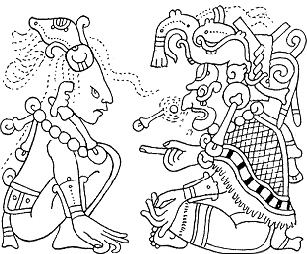
The Maya death gods known by a variety of names, are two basic types of death gods who are respectively represented by the 16th-century Yucatec deities Hunhau and Uacmitun Ahau mentioned by Spanish Bishop Diego de Landa. Hunhau is the lord of the Underworld. Iconographically, Hunhau and Uacmitun Ahau correspond to the Gods A and A' . In recent narratives, particularly in the oral tradition of the Lacandon people, there is only one death god, who acts as the antipode of the Upper God in the creation of the world and of the human body and soul. This death god inhabits an Underworld that is also the world of the dead. As a ruler over the world of the dead, the principal death god corresponds to the Aztec deity Mictlāntēcutli. The Popol Vuh has two leading death gods, but these two are really one: Both are called "Death," but while one is known as "One Death," the other is called "Seven Death." They were vanquished by the Hero Twins.
Mesoamerican religion is a group of indigenous religions of Mesoamerica that were prevalent in the pre-Columbian era. Two of the most widely known examples of Mesoamerican religion are the Aztec religion and the Mayan religion.
